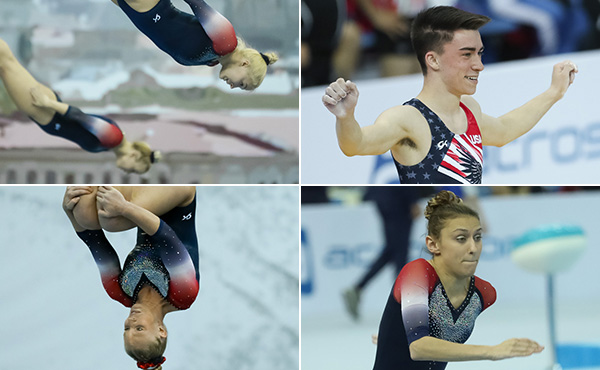
- Qualifaction Results: Synchro | Men’s Tumbling | Women’s Double Mini
- All-Around Team Results: Qualification | Final
- Photo Galleries
- FIG Worlds Microsite
By Blythe Lawrence
St. Petersburg, Russia — Tristan van Natta thought little of it when she put her foot through the springs surrounding the double mini-trampoline bed two days before competing at the World Trampoline and Tumbling Championships.
Bouncing back is something van Natta has become accustomed to. Cranial reconstruction surgery after a tumor was removed from her head when she was 11 only took her out of the gym for seven months. Getting her skills back following a nearly 18-month hiatus that spanned from 2016 well into 2017 was accomplished in a matter of weeks.
So a little ankle injury in training? “It’s a little bit puffy, but I’m trying to push through the pain and make it work,” she said. “I fell through the side of the double mini through the springs, kind of twisted it, crushed it a little bit, but it’s working better than it did yesterday.”
It worked in Thursday’s women’s double mini prelims, where Van Natta opened her campaign by sticking her first pass cold. Her combined score of 69.800 points qualified her to Saturday’s final in second place, her highest placement at her five World Championships.
“It was really exciting. Last year I had a little bit of a hiccup in prelims, so this year I was looking just to hit two solid passes,” van Natta said. “Yesterday all day I was in my head a lot, until I went back to the hotel and got myself to calm down, stayed active with it and kept it elevated, kept it rested, and this morning I was like, ‘I’m doing this, I’m ready to go!’”
Van Natta was one of five American athletes to reach finals on the second day of competition in St. Petersburg. Seventeen-year-old Kaden Brown, competing in his first senior Worlds, shone on his difficult triple back somersault pass to qualify to the men’s tumbling final in fourth place, while 2016 Olympian Nicole Ahsinger and Sarah Webster were sixth in women’s synchronized trampoline. Kristle Lowell, the 2013 World gold medalist in women’s double-mini, turned in two solid passes to qualify for the final in eighth place.
They’ll all join tumbler Hope Bravo and double mini trampolinists Ruben Padilla and Matthew Hawkins as they battle for medals during Friday and Saturday’s finals. Ahsinger has also qualified for the semifinal in women’s trampoline, which will whittle 24 competitors down to eight.
Additionally, veteran Alex Renkert is the first reserve for the men’s tumbling final and Cody Gesuelli and Joey Isenberg are second reserve for the men’s synchro final.
On the backs of solid performances from top performers Ahsinger (women’s trampoline and synchro), Cody Gesuelli (men’s trampoline and synchro), Webster (women’s synchro), Joey Isenberg (men’s synchro), van Natta (women’s double-mini), Padilla (men’s double-mini), Bravo (women’s tumbling) and Brown (men’s tumbling), the U.S. team also finished fourth in the inaugural World all-around team final Thursday evening. Featuring the top five countries from the qualification round, the format of the brand new team all-around competition had the top overall performer from each discipline do one routine. Depending on where the gymnast ranked compared to other competitors in the same discipline, he or she earned points for their team, and the team with the largest points total took gold.
Hitting six of their eight routines, the U.S. amassed 24 points to tie with Portugal and Canada in the rankings. The tie was broken by taking into account the total score of each team, which dropped the U.S. out of the medals.
For Ahsinger and Gesuelli that meant doing back-to-back routines Thursday night as the U.S. battled eventual champion China, silver-medalist Portugal, bronze-medalist Canada and host Russia for overall team honors. And while the desired medal did not materialize, the support of their teammates made it a positive experience, Gesuelli said.
“After synchro prelims this afternoon, when I was told I’d be performing in both individual and synchro, I was like, ‘oh man, that seems like a lot!’” he laughed. “But once I walked past the curtain and I was on the floor as an individual, my nerves calmed down quite a lot and I was feeling more pumped up. Hearing my teammates and the crowd cheering me on, that really helped me. Hearing our teammates cheering us on and hearing someone say, ‘Come on boys, bring it home,’ I wasn’t feeling any nerves at that point.”




